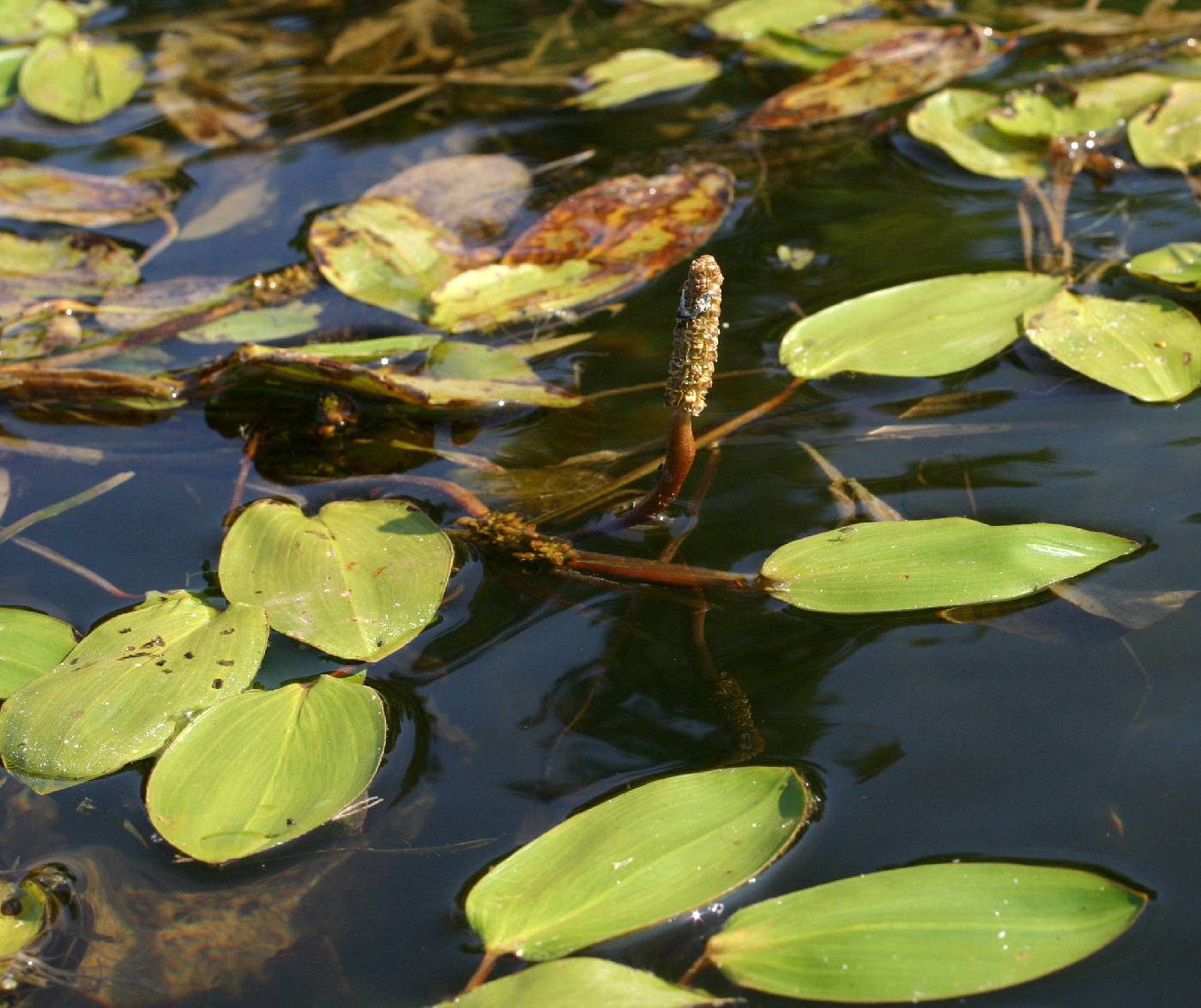|
|
|
|
Family: Potamogetonaceae
largeleaf pondweed
|
Rhizomes present. Cauline stems terete, often rusty spotted, 6--110 cm; nodal glands absent. Turions absent. Leaves both submersed and floating or floating absent, ± spirally arranged. Submersed leaves petiolate, lax; stipules persistent, conspicuous, convolute, free from blade, light brown, not ligulate, 1.5--11.7 cm, not fibrous, not shredding at tip, apex acute; petioles terete, 0.9--11.5 cm; blade light to dark green, ovate to oblanceolate, distinctly arcuate, 5--12.5 cm ´ 15--58 mm, base rounded to acute, without basal lobes, not clasping, margins entire, crispate, apex not hoodlike, acute to round-apiculate, lacunae absent; veins 19--49. Floating leaves: petioles continuous in color to apex, 2.3--22.6 cm; blade adaxially light green, lanceolate to round elliptic, 4.3--9.2 cm ´ 25--38 mcm, base rounded to cordate, apex acute to rounded; veins 27--49. Inflorescences unbranched, emersed; peduncles not dimorphic, terminal or axillary, erect, cylindric, 4.5--22.3 cm; spikes not dimorphic, cylindric, 34--65 mm. Fruits sessile, reddish brown, obovoid, turgid, abaxially keeled, laterally ridged, 5--6.7 ´ 4.5--5.2 mm, lateral ridges without points; beak erect, 0.5--0.8 mm; sides without basal tubercles; embryo with full spiral. 2n = 52. Flowering summer--fall. Waters of lakes, ponds, streams, and rivers; 0--1900(--2900) m; B.C., Man., N.B., Nfld. and Labr. (Nfld.), N.S., Ont., Que., Sask.; Ala., Ark., Calif., Conn., Ga., Idaho, Ill., Ind., Iowa, Kans., Maine, Md., Mass., Mich., Minn., Mo., Mont., Nebr., N.H., N.J., N.Y., N.C., Ohio, Okla., Oreg., Pa., R.I., S.Dak., Tenn., Vt., Va., Wash., W.Va., Wis., Wyo. No specimens have been seen from Kentucky or Texas, but the species is to be expected there. Potamogeton amplifolius is common throughout much of North America. Its submersed leaves are larger than those of most other species of Potamogeton, are arcuate, and have more veins than do any other species. One hybrid, Potamogeton amplifolius ´ P. illinoensis (= P. ´ scoliophyllus Hagström), has been described.
Perennial submersed aquatic herb with rhizomes 6 cm - 1 m tall Stem: elongate, mostly unbranched, jointed, often with rusty spots. Inflorescence: an upright, dense, cylindrical spike of flowers, emersed, unbranched, 2 - 6.5 cm long, on a terminal or axillary stalk. Stalk stout, cylindrical, 4.5 - 22 cm long, to 4 mm wide. Flowers: greenish, tiny. Stamens four. Anthers two-chambered, with four edge-to-edge sepal-like outgrowths. Fruit: an achene, stalkless, reddish brown, 4 - 6.5 mm long, 4.5 - 5 mm wide, obliquely reverse egg-shaped, plump, keeled, with an upright, 0.5 - 1 mm long beak. Keels three, low, rounded. Submersed leaves: more or less arranged spirally, on 0.9 - 11.5 cm long stalks, translucent, 5 - 12.5 cm long, 1.5 - 6 cm wide, egg-shaped to reverse lance-shaped with a rounded to pointed base and tip, distinctly arching, 19- to 49-veined. Stipules axillary, free from leaf blade, light brown, rolled up, 1.5 - 11.5 cm long. Floating leaves: (if present) on 2 - 22.5 cm long stalks, 4.5 - 10 cm long, half as wide, lance-shaped to round-elliptic with a rounded base and rounded to pointed tip, 27- to 49-veined, leathery, firmer than submersed leaves. Similar species: The large and distinctly arching submersed leaves help distinguish this species. They also exhibit the highest number of veins. Flowering: June to October Habitat and ecology: Common in lakes. Occurence in the Chicago region: native Notes: Plants in the genus Potamogeton are very important to wildlife, offering habitat and food for many aquatic animals. Etymology: Potamogeton comes from the Greek words potamos, meaning river, and geiton, meaning neighbor, referring to the habitat of these plants. Amplifolius means "ample foliage." Author: The Morton Arboretum Stem elongate, usually simple; principal submersed lvs falcately folded, 25-37-veined, 8-20 cm, on petioles 1-6 cm, acute at both ends, the lower lanceolate, 2 cm wide, the upper gradually wider; floating lvs elliptic, 5-10 cm, half as wide, obtuse, rounded at base, many-nerved, on petioles 8-20 cm; stipules axillary, free, open, 2-keeled, 3.5-12 cm, tapering to a sharp slender point; peduncles stout, 8-20 cm, somewhat clavate, 3-4 mm thick at the top; spikes dense, 2-5 cm; frs obliquely obovoid, 4-5.5 mm (incl. the 1 mm beak), with 3 low, rounded keels; 2n=52. Ponds and lakes; Que. to B.C., s. to Ala. and Calif. Gleason, Henry A. & Cronquist, Arthur J. 1991. Manual of vascular plants of northeastern United States and adjacent Canada. lxxv + 910 pp. ©The New York Botanical Garden. All rights reserved. Used by permission. |
|
|
|


